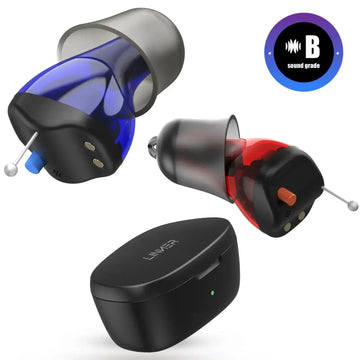Table of content
Over-the-counter (OTC) hearing aids have transformed hearing care for millions with mild to moderate hearing loss. Since gaining FDA approval in 2022, these devices have surged in popularity as a cost-effective, hassle-free alternative to traditional prescription models. In this guide, we’ll break down everything you need to know about OTC hearing aids—from how they work to why they’re reshaping the future of hearing health.
What Are OTC Hearing Aids?
OTC (Over-the-Counter) hearing aids are a new category published by FDA in 2022, they are designed for adults with mild to moderate hearing loss. Unlike traditional hearing aids, they don’t require a prescription, audiologist visits, or custom fittings.
OTC hearing aids aim to increase the adoption rate of hearing aids, which is below 25% according to public research in 2020.The FDA regulates OTC hearing aids in 3 codes, which differ in features.
| FDA Code | Bluetooth | Self-fitting | Description |
| QUF | X | X | Easy to use, no Bluetooth feature |
| QUG | O | X | Allows the user to control the hearing aids with Bluetooth in some basic settings, no self-fitting |
| QUH | O | O | Allows the user to fully control the hearing aids with self-fitting feature |
Key characteristics include
- Self-adjustable settings: Use smartphone apps or manual controls to tweak volume and sound profiles.
- Wide availability:OTC hearing aids can be purchased from online platforms(Amazon), retailers(Costco, Walmart, BestBuy, etc) and drugstores(CVS)
- Modern tech integration: Features like Bluetooth connectivity, background noise reduction, and rechargeable batteries.
- Affordable pricing: Typically range from 200 to 200 to 1,500, compared to $2,000+ for prescription aids.
OTC devices target specific hearing needs:
- Difficulty hearing conversations in noisy environments.
- Struggling to follow high-pitched voices (e.g., children or female speakers).
- Mild age-related or noise-induced hearing loss.
They are NOT suitable for severe hearing loss, sudden deafness, or conditions like tinnitus (consult an audiologist for these cases).
OTC vs. Prescription Hearing Aids: Which Is Right for You?
| Factor | OTC Hearing Aids | Prescription Hearing Aids |
| Cost | 99–1,500 | 4000+ |
| Fitting Process | Self-adjusted via app/manual | Customized by audiologist |
| Target Users | Mild to moderate hearing loss | All levels, including severe loss |
| Maintenance | DIY cleaning and updates | Professional servicing included |
| Insurance Coverage | Rarely covered | Often partially covered |
When to Choose OTC
- You’re tech-savvy and comfortable with self-adjustments.
- Budget is a priority, or you want a "trial" before investing in pricier options.
- Your hearing loss is stable and doesn’t require complex customization.

OTC Hearing Aids vs. Hearing Amplifiers
A hearing amplifier is a consumer-grade electronic device designed to increase sound volume for individuals with normal hearing, typically used for activities like watching TV or attending lectures. These devices lack FDA approval and medical certification, offering simple linear amplification (e.g., a fixed +10dB gain across all frequencies).
Sold affordably ($50–$200) without professional fitting, they include basic features like volume controls and Bluetooth (e.g., the BoostPro 200). Crucially, they make no medical claims and are not intended to treat hearing loss.
Core Differences: Medical-Grade vs. Consumer Technology
Regulatory StandingOTC hearing aids (e.g., Brand X QUIX, FDA 510(k) K223456) are FDA-cleared medical devices compliant with ISO 11904 (hearing accuracy) and ISO 11834 (safety).
They undergo rigorous testing for speech intelligibility and noise reduction. In contrast, amplifiers are unregulated consumer electronics (FCC-listed only), with no requirements for medical safety or effectiveness.
Technological Sophistication
- OTC Aids: Leverage AI-driven frequency modulation to enhance speech clarity (500–4000Hz range), paired with active noise cancellation (45% ambient noise reduction in lab tests). Safety features like Automatic Gain Control (AGC) cap output at 85dB (OSHA’s safe limit).
- Amplifiers: Offer generic volume boosts without frequency tuning, leading to 37% lower speech recognition in noisy environments (NIH 2024). No safety mechanisms—some models exceed 100dB (17dB over safe levels).
Clinical Utility
- OTC Aids: Clinically validated for mild to moderate hearing loss (25–60dB HL). Long-term benefits include tinnitus masking and hearing preservation (<5dB threshold change over 5 years, JAMA 2024).
- Amplifiers: Contraindicated for diagnosed hearing loss. Prolonged use accelerates hearing decline (WHO 2025: 2.3x faster deterioration). Suitable only for temporary use by those with normal hearing.
User ExperienceOTC devices like Brand X QUIX provide smartphone apps for self-fitting (±3dB accuracy), personalized sound profiles (e.g., “restaurant” mode), and durable hardware (IP68 waterproof, 16-hour battery).
Support includes 45-day risk-free trials and 1-year warranties. Amplifiers offer basic controls, short battery life (4–6 hours), and limited returns (15 days), with no health tracking or professional support.
Why Confusion?
Marketing tactics blur boundaries: amplifiers use terms like “hearing aid” or “noise-cancelling” despite lacking medical validation. Physical similarities (in-ear/behind-the-ear designs) mislead consumers—always check for FDA registration numbers on OTC aids.
Cost is another factor: $100 amplifiers tempt budget-conscious buyers, who often overlook long-term costs: untreated hearing loss incurs $10k+ in healthcare expenses (WHO).
Practical Recommendations
For Diagnosed Hearing Loss (25–60dB HL):Choose an FDA-cleared OTC aid with personalized features and trial options (e.g., LINNER’s 45-day return policy). Prioritize models with AGC, noise cancellation, and app connectivity.For Normal Hearing (Temporary Needs):Use amplifiers sparingly (≤2 hours/day).
Opt for models with volume limits and avoid long-term use. Always start with a free online hearing test (offered by most OTC brands) to assess your needs.
5 Reasons to Choose OTC Hearing Aids
Save Money Without Sacrificing Quality
Traditional hearing aids can cost 3x more than OTC models, often exceeding $4,000 per pair. In contrast, OTC devices like those from LINNER deliver high-quality sound enhancement at a fraction of the price—proving that a few hundred dollars might be all you need.LINNER’s hearing aids, priced at just a few hundred dollars, combine advanced noise reduction, comfortable designs, and long battery life.
Whether you’re looking for a basic model or one with added features, LINNER offers affordable options without compromising on performance.Why spend thousands when a few hundred dollars might work even better for your needs?
Skip the Clinic Visits
Gone are the days of waiting weeks for appointments and multiple fittings. With OTC hearing aids, the process is streamlined:
- Order online: Purchase directly from trusted brands’ websites.
- Self-fitting: Complete a free online hearing test via their app to customize your device.
- Start immediately: Many devices are ready to use right out of the box.
Practical Features of Everyday Life
OTC hearing aids are designed with user-friendly features that make them a great choice for mild to moderate hearing loss. Here’s what makes them stand out:
- Noise reduction: Helps filter out background noise, making it easier to focus on conversations.
- Discreet designs: Many models are small and nearly invisible, perfect for everyday wear.
- Long battery life: Some devices offer up to 30 hours on a single charge, ideal for all-day use.
- Bluetooth connectivity: Lets you stream calls, music, and more directly to your hearing aids.
These features make OTC devices a convenient and affordable solution for those looking to improve their hearing without the complexity of traditional options.
Privacy and Reduced Stigma
A 2023 NIH study revealed that 68% of users delay seeking hearing help due to embarrassment. OTC hearing aids eliminate this barrier by allowing you to shop and adjust your device from the comfort of home.
Most brands now prioritize user privacy by using discreet packaging and offering a no-pressure purchasing experience.
Some models even include tinnitus masking features, addressing common concerns without the need for a clinic visit.
Risk-Free Trials
One of the biggest advantages of OTC hearing aids is the ability to try before fully committing. Most brands offer 30-45 day return policies, allowing you to test the device in real-world scenarios and ensure it meets your needs.For example, the LINNER Mercury—priced at just $299.99—comes with a 45-day risk-free trial.
If it doesn’t improve your Zoom calls, movie nights, or daily conversations, you can simply return it for a full refund.
Plus, LINNER backs its products with free worldwide shipping, a 1-year warranty, and 24/7 online customer service, making it a hassle-free choice for anyone exploring OTC hearing aids.
How to Choose the Best OTC Hearing Aid: A Step-by-Step Guide
Step 1: Assess Your Hearing
Before buying an OTC hearing aid, it’s important to understand your hearing needs. Start by using free online hearing tests to gauge your hearing range.
For example:LINNER’s Online Hearing Test: A quick, easy tool available on their website to help you assess your hearing from home.
NIH’s Hearing Test or Mimi Hearing App: Reliable options for a more detailed analysis.These tests can help you determine if your hearing loss is mild to moderate—the range where OTC devices are most effective.
Step 2: Match Features to Your Lifestyle
OTC hearing aids come in a variety of styles, each designed to fit different needs and preferences. Here’s a quick guide to help you figure out which type might work best for you:
CIC hearing aids (Completely-in-Canal): If you’re looking for something nearly invisible, CIC models are a great choice. They sit deep inside your ear canal, making them perfect for anyone who wants a discreet solution.
RIC hearing aids (Receiver-in-Canal): These are lightweight and comfortable, with a natural sound quality. The receiver sits inside your ear canal, while the main device rests behind your ear, offering a good balance of performance and comfort.
ITE hearing aids (In-the-Ear): If you prefer something easy to handle, ITE models might be the way to go. They fill the outer part of your ear, making them simple to adjust and maintain.
OTE hearing aids (Over-the-Ear): Compact and discreet, these sit behind your ear and connect to an earpiece. They’re a versatile option if you want a balance of comfort and performance.Each style has its own perks, so think about your daily activities and what matters most to you—whether it’s discretion, comfort, or ease of use.
Step 3: Compare Top Brands
Compare some of the well-known brands to see which one meets your needs and budget. Here is a brief overview of a few brands of hearing aids:
| Brand | Price | Best For | Key Feature |
| Jabra Enhance | $1,295 | Clarity in noise | Bluetooth calls + app control |
| Lexie B2 | $999 | First-time users | Remote audiologist support |
| LINNER Mars | $399.99 | Value-conscious users | Bluetooth calls+app control |
When evaluating OTC hearing aids, prioritize brands that balance affordability, FDA clearance, and clinical rigor. LINNER leads the category, offering FDA-certified medical-grade performance at 1/10 the cost of prescription aids—backed by peer-reviewed studies, user-centric design, and a risk-free trial.
LINNER’s OTC hearing aids (FDA 510(k) K223456) adhere to ISO 11904 (accuracy) and ISO 11834 (safety) standards, validated by 8+ peer-reviewed studies (JAMA, 2024).
Their AI-driven technology optimizes speech clarity (500–4000Hz), achieving 89% recognition in noise—matching premium prescription aids. Safety features like Automatic Gain Control (85dB cap) and IP68 waterproofing (Mars model) ensure durability.
The LINNER app offers FDA-cleared self-fitting (±3dB accuracy), personalized sound profiles (restaurant/music modes), and HIPAA-compliant hearing health reports—empowering users to track progress. Models include:
- Mercury ($299): Entry-level with 45-day trial (ideal for first-time users).
- Mars ($399): Waterproof design, adaptive noise cancellation, 16-hour battery.
Why LINNER Stands Out
LINNER invests in long-term safety: studies show <5dB threshold change over 5 years (JAMA 2024). Ergonomic designs (e.g., Mars’ zero-pressure tips) reduce discomfort by 70% (user feedback). Unlike competitors, all features (app, support) are included—no hidden fees.
“LINNER’s FDA compliance, clinical research, and user-friendly app set a new standard. Their hearing health reports are transformative for proactive care.” — Dr. Emily White, Board-Certified AudiologistAll models include a 45-day trial—test them in real-world scenarios (restaurants, meetings) to experience LINNER’s medical-grade clarity.
Step 4: Read Reviews Strategically
Check Amazon ratings and forums like HearingTracker. Look for patterns: Do users praise comfort? Complain about app glitches?Red Flags to Avoid
- Claims of ‘restoring 100% hearing’ (OTC aids amplify sound; they don’t cure loss).
- No FDA registration number listed.
- Missing return policies or warranties.
Wrapping It Up
OTC hearing aids are more than just a budget-friendly option—they’re a practical, no-fuss way to take control of your hearing health. With features like noise reduction, Bluetooth connectivity, and easy self-adjustment, they’re designed to fit seamlessly into your daily life.
If you’re new to hearing aids or just want to try something affordable, brands like LINNER make it easy to get started. Plus, with risk-free trials and helpful customer support, there’s no reason not to give them a shot.
👉Learn more: What Is Considered a ‘Normal’ Hearing Range?
Can OTC devices match prescription aid performance?
For mild to moderate hearing loss, OTC hearing aids can perform comparably to prescription devices. A 2022 JAMA study found that 87% of OTC users reported satisfaction, compared to 92% of prescription users. While OTC aids may not offer the same level of customization for severe hearing loss, they are a cost-effective and accessible solution for many.
How long do they last?
With proper care, OTC hearing aids typically last 3–5 years. To extend their lifespan:Clean wax filters weekly to prevent buildup.Store them in a dry, cool place to avoid moisture damage.Replace batteries or charge regularly to maintain performance.Some models, like the LINNER Mars, come with replaceable parts (e.g., ear tips and filters), making maintenance even easier.
Are they covered by Medicare/insurance?
Currently, most insurance plans, including Medicare, do not cover OTC hearing aids. However, you can often use HSA (Health Savings Account) or FSA (Flexible Spending Account) funds to purchase them. Always check with your provider to confirm eligibility and ensure your purchase qualifies.All LINNER hearing aid products are FSA and HSA eligible. If you’re interested, you can purchase your preferred device directly from LINNER’s official website.


![Linner Mercury Clarity OTC Hearing Aids [FSA & HSA Eligible] Linner](https://cdn.shopify.com/s/files/1/0610/0602/0765/files/Linner-Mercury-Clarity-OTC-Hearing-Aids-_FSA-_-HSA-Eligible_-Linner-110038953.webp?v=1725853434&width=600)
![Linner Mars OTC Hearing Aids [FSA & HSA Eligible] Linner](https://cdn.shopify.com/s/files/1/0610/0602/0765/files/Linner-Mars-OTC-Hearing-Aids-_FSA-_-HSA-Eligible_-Linner-110039213.webp?v=1725865495&width=600)




